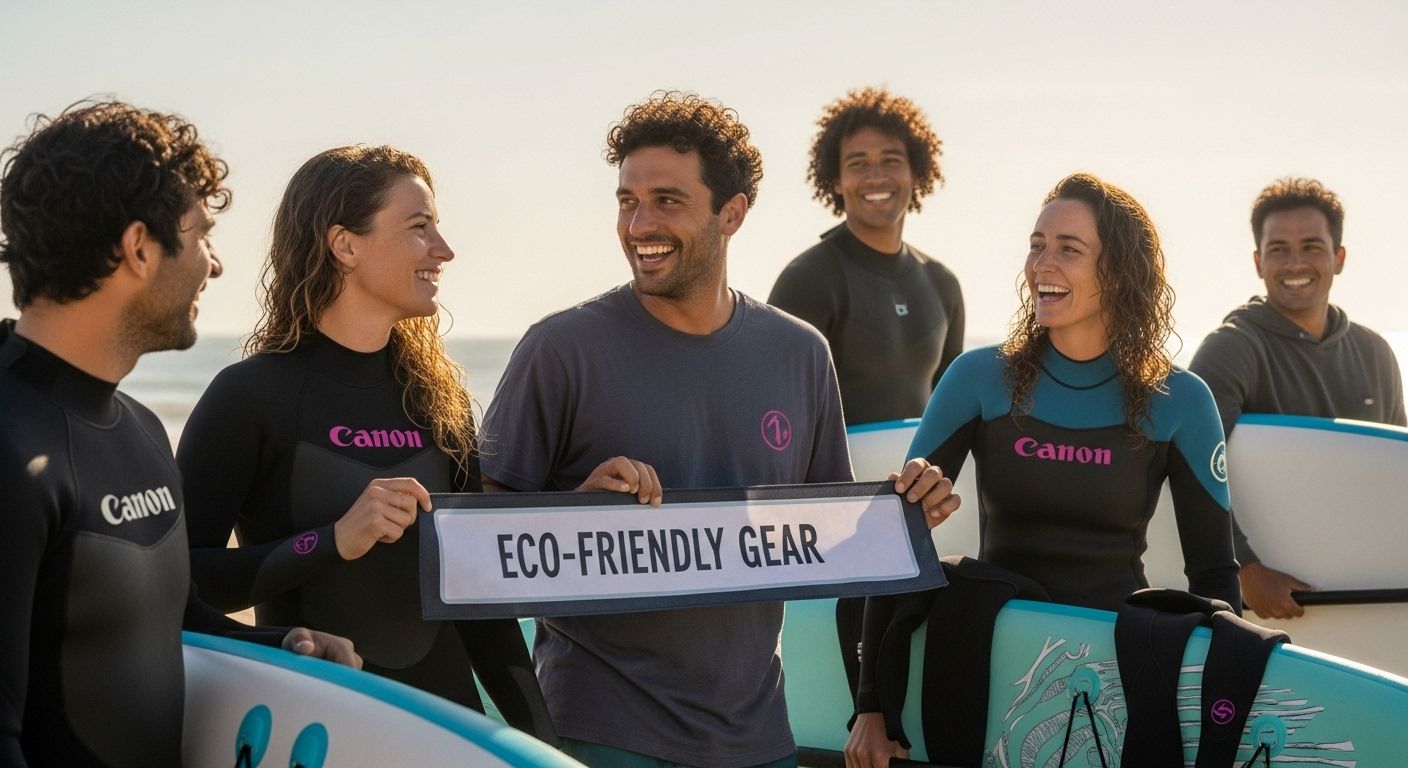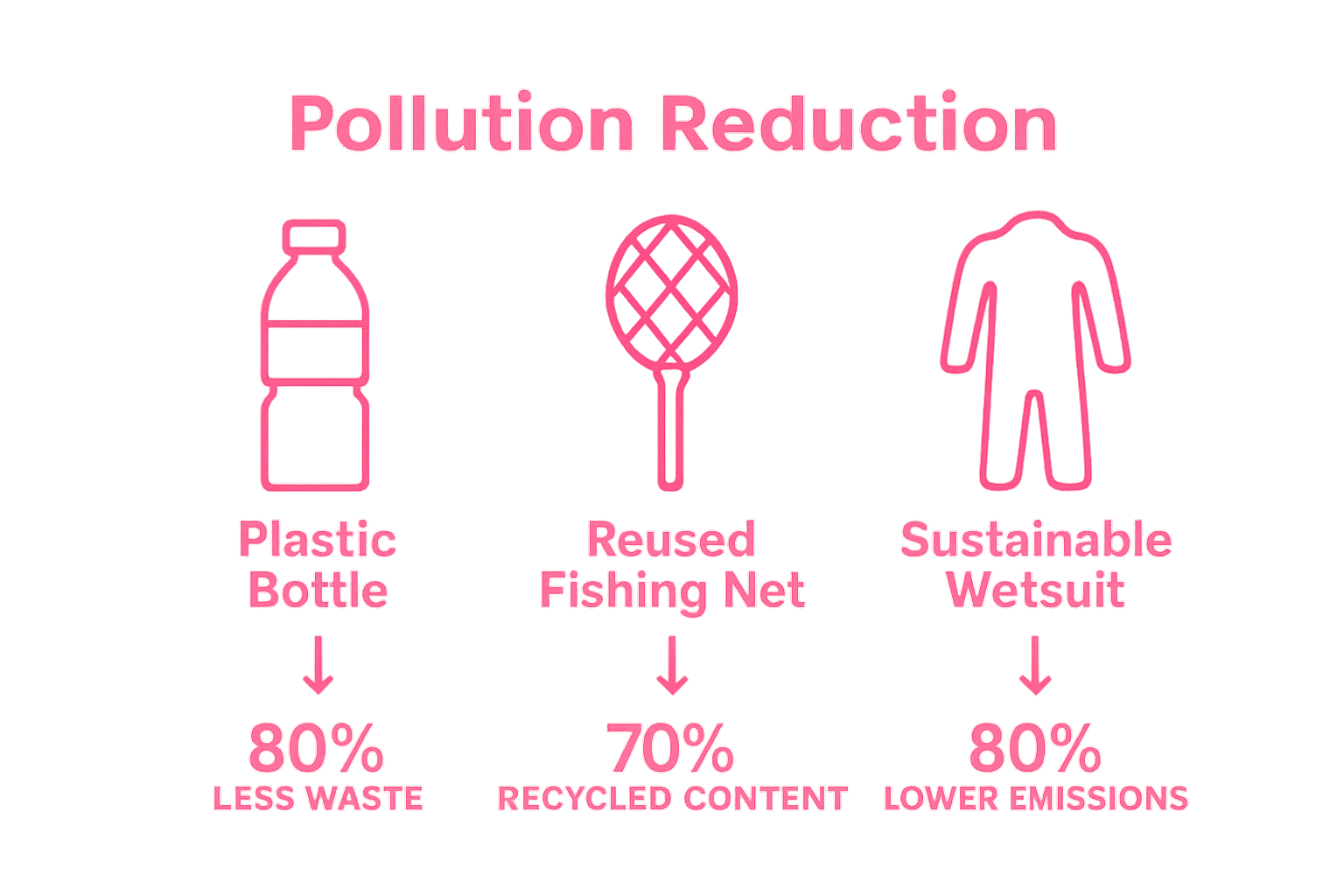
Eco-friendly gear is changing the way people experience watersports. Every year, watersports enthusiasts dump millions of pounds of non-biodegradable equipment into oceans and lakes, hurting fragile marine life. Most people think using sustainable equipment means sacrificing performance or comfort, but today’s eco-friendly options actually keep pace with traditional gear and help restore the environment at the same time.
Table of Contents
- The Importance Of Eco-Friendly Gear In Watersports
- What Is Eco-Friendly Gear And How Is It Made?
- Benefits Of Using Eco-Friendly Gear For The Environment
- Real-World Examples Of Eco-Friendly Gear In Watersports
- The Future Of Eco-Friendly Gear In Watersports
Quick Summary
| Takeaway | Explanation |
|---|---|
| Choose eco-friendly gear for marine health | Selecting sustainable watersports equipment helps preserve marine ecosystems and reduces pollution. |
| Focus on sustainable materials and practices | Opt for products made from biodegradable or recycled materials to minimize environmental impact. |
| Support marine conservation with your purchases | Eco-friendly gear contributes to marine ecosystem restoration and promotes responsible consumption. |
| Stay informed about innovative gear technologies | Keep up with emerging sustainable materials and production techniques for informed purchasing decisions. |
| Encourage circular economy principles in gear design | Advocate for equipment designed for longevity and recyclability, reducing waste and supporting sustainability. |
The Importance of Eco-Friendly Gear in Watersports
Watersports enthusiasts are increasingly recognizing the critical role of eco-friendly gear in preserving marine ecosystems and minimizing environmental impact. As our understanding of human interactions with aquatic environments deepens, the adoption of sustainable equipment becomes not just a choice but a responsibility.
Environmental Protection Through Conscious Equipment Selection
Eco-friendly gear represents a fundamental shift in how watersports participants approach their recreational activities. By selecting equipment manufactured with sustainable materials and processes, athletes directly contribute to reducing pollution and protecting marine habitats. Sustainable gear solutions are designed to minimize ecological footprints while maintaining high performance standards.
Key considerations in eco-friendly gear selection include:
- Materials that are biodegradable or recyclable
- Manufacturing processes with reduced carbon emissions
- Products that support marine conservation efforts
Reducing Marine Ecosystem Disruption
Traditional watersports equipment often introduces harmful chemicals and non-biodegradable materials into marine environments. According to research from the Scuba Foundation, sustainable gear can significantly reduce potential damage to underwater ecosystems. Neoprene alternatives, biodegradable plastics, and responsibly sourced materials help minimize long-term environmental consequences.
When watersports enthusiasts choose eco-friendly gear, they become active participants in marine conservation. The equipment becomes more than just a tool for recreation it transforms into a statement of environmental stewardship and commitment to preserving our planet’s delicate aquatic systems.
What is Eco-Friendly Gear and How is it Made?
Eco-friendly gear represents a transformative approach to manufacturing watersports equipment that prioritizes environmental sustainability and minimizes ecological impact. By reimagining traditional production methods, manufacturers are developing innovative solutions that protect marine ecosystems while delivering high performance.
Defining Eco-Friendly Watersports Equipment
Eco-friendly gear goes beyond conventional manufacturing by integrating sustainable materials, responsible production processes, and environmental consciousness. According to research in Materials Science, these specialized products are characterized by several fundamental attributes:
- Materials: Utilizing biodegradable, recycled, or renewable resources
- Manufacturing: Implementing low-carbon production techniques
- Lifecycle: Designing products with minimal environmental footprint
- Performance: Maintaining superior functional qualities while reducing ecological impact
Innovative Manufacturing Techniques
Modern eco-friendly gear production involves cutting-edge techniques that transform waste materials into high-performance equipment. Manufacturers are now exploring revolutionary approaches such as converting plastic waste into durable watersports gear and developing water-based fabric technologies that reduce chemical usage.
Specific manufacturing strategies include:
- Recycling marine plastics into gear components
- Using bio-based polymers derived from renewable sources
- Implementing 3D printing technologies with biodegradable materials
These advanced methods not only create superior equipment but also actively contribute to marine conservation efforts.
Sustainable gear solutions demonstrate how technological innovation can align environmental responsibility with exceptional product performance, offering watersports enthusiasts a meaningful way to reduce their ecological impact.
Benefits of Using Eco-Friendly Gear for the Environment
Eco-friendly watersports gear delivers profound environmental advantages that extend far beyond individual product performance. By choosing sustainable equipment, watersports enthusiasts become active participants in marine ecosystem preservation and global conservation efforts.
Reducing Plastic Pollution and Environmental Waste
Traditional watersports equipment contributes significantly to marine pollution through non-biodegradable materials and chemical-intensive manufacturing processes. According to the International Union for Conservation of Nature, eco-friendly gear provides critical environmental benefits by minimizing waste and reducing long-term ecological damage.
Key environmental advantages include:

- Decreasing microplastic release into marine environments
- Limiting chemical contamination of water ecosystems
- Supporting circular economy principles through recyclable materials
Supporting Marine Ecosystem Restoration
Eco-friendly watersports gear serves as more than just equipment it represents a commitment to marine conservation. Manufacturers are increasingly developing products that directly contribute to ecosystem restoration. Sustainable gear solutions demonstrate how technological innovation can align product design with environmental protection.
The broader impact of eco-friendly gear extends to:
- Encouraging sustainable manufacturing practices
- Raising awareness about marine conservation
- Creating economic incentives for environmentally responsible production
By selecting gear manufactured with sustainable materials and processes, watersports participants actively participate in protecting marine biodiversity and promoting a more responsible approach to recreational equipment consumption.
The following table summarizes key differences between traditional and eco-friendly watersports gear to help readers quickly compare their features and environmental impacts.
| Feature | Traditional Watersports Gear | Eco-Friendly Watersports Gear |
|---|---|---|
| Material Sources | Petroleum-based, non-renewable | Biodegradable, recycled, renewable |
| Environmental Impact | High pollution, ecosystem harm | Reduced pollution, conservation aid |
| Manufacturing Process | Chemical-intensive, high emissions | Low-carbon, sustainable practices |
| Product Lifecycle | Non-biodegradable, single-use | Designed for recyclability, longevity |
| Performance | High, but with ecological cost | High, with reduced ecological impact |
| Marine Conservation Support | Rarely prioritized | Central to product design |
Real-World Examples of Eco-Friendly Gear in Watersports
The watersports industry is experiencing a remarkable transformation with innovative eco-friendly gear that demonstrates how sustainability and high performance can coexist. These practical examples showcase the potential for environmental responsibility in equipment design and manufacturing.
Sustainable Wetsuit Innovations
Wetsuits represent a critical area of eco-friendly gear development. According to research in environmental sports technology, manufacturers are replacing traditional petroleum-based neoprene with groundbreaking alternatives that significantly reduce environmental impact. Natural rubber sourced from sustainable forests and recycled plastic materials are now being transformed into high-performance watersports equipment.
Key sustainable wetsuit innovations include:
- Yulex natural rubber wetsuits derived from sustainably managed plantations
- Wetsuits manufactured using recycled plastic bottles
- Biodegradable neoprene alternatives with reduced carbon footprints
Eco-Conscious Watersports Equipment Design
Beyond wetsuits, manufacturers are reimagining entire product lines with environmental consciousness. Sustainable gear solutions are emerging across various watersports disciplines, demonstrating a comprehensive approach to green equipment development.
Innovative examples of eco-friendly watersports gear include:
- Surfboards constructed from recycled ocean plastics
- Paddles manufactured using reclaimed fishing nets
- Kayaks and paddleboards made with biodegradable composite materials
These real-world examples illustrate how technological innovation and environmental responsibility can create high-performance watersports equipment that minimizes ecological impact while delivering exceptional user experiences.
Here is a table highlighting examples of sustainable materials and innovations in eco-friendly watersports gear, showcasing advances discussed throughout the article.
| Gear Type | Sustainable Material or Innovation | Environmental Benefit |
|---|---|---|
| Wetsuits | Yulex natural rubber | Renewable, biodegradable |
| Wetsuits | Recycled plastic bottles | Diverts plastic waste, reduces pollution |
| Wetsuits | Biodegradable neoprene alternatives | Lower carbon footprint, decomposable |
| Surfboards | Recycled ocean plastics | Reduces marine debris, supports recycling |
| Paddles | Reclaimed fishing nets | Utilizes waste, lessens ocean pollution |
| Kayaks/Paddleboards | Biodegradable composite materials | Decomposes safely, less waste |

The Future of Eco-Friendly Gear in Watersports
The watersports industry stands at a critical intersection of technological innovation and environmental responsibility. As global awareness of ecological challenges grows, manufacturers and designers are pioneering transformative approaches to sustainable equipment development that promise to revolutionize how we interact with marine environments.
Emerging Technologies and Material Innovations
According to research from World Sailing, the future of eco-friendly watersports gear will be characterized by groundbreaking technological solutions that minimize environmental impact. Advanced materials and manufacturing techniques are enabling unprecedented levels of sustainability without compromising performance.
Key technological developments include:
- Biodegradable composite materials that decompose safely
- Advanced recycling technologies for gear regeneration
- Smart textiles with embedded environmental tracking capabilities
Holistic Sustainability Approach
Future eco-friendly gear development extends beyond material selection to encompass entire product lifecycles. Sustainable gear solutions are increasingly designed with circular economy principles, emphasizing product longevity, repairability, and eventual responsible recycling.
Comprehensive sustainability strategies will focus on:
- Designing gear for extended product lifespans
- Creating closed-loop recycling systems
- Developing transparent supply chain practices
The evolution of eco-friendly watersports gear represents more than technological advancement it symbolizes a fundamental reimagining of our relationship with marine ecosystems, where environmental stewardship and high-performance equipment coexist harmoniously.
Move Toward Sustainable Watersports Gear with Confidence
You care deeply about protecting the oceans and reducing environmental harm each time you choose your watersports equipment. The article explored how eco-friendly gear like biodegradable materials and responsible manufacturing creates real change by reducing plastic pollution and supporting marine ecosystems. Yet, you may face a clear pain point: how can you make everyday gear choices that actually support your values and the planet?
Discover the Wetsuit Hangers – Surf Vida lineup. Each hanger is built strong enough to support wet wetsuits while being designed for space-saving storage. Most importantly, it is 3D printed from PLA+—a biodegradable plastic highlighted in the article as a crucial step for lowering your ecological footprint. Wide shoulders help protect your wetsuit and promote faster drying, which furthers the product’s conservation benefits. 
If you are serious about choosing equipment that matches the eco-friendly principles you just read about, now is the perfect time to act. Shop directly at https://surfvida.com and see how easy it is to upgrade to solutions that preserve both your gear and the environment. Take the next step today and be part of the movement for sustainable watersports gear.
Frequently Asked Questions
What is eco-friendly gear in watersports?
Eco-friendly gear in watersports refers to equipment that is manufactured using sustainable materials, responsible production processes, and is designed to minimize ecological impact. This includes items made from biodegradable, recycled, or renewable resources and those that implement low-carbon manufacturing techniques.
How does using eco-friendly gear benefit the marine environment?
Using eco-friendly gear helps reduce pollution and environmental waste by minimizing the introduction of harmful chemicals and non-biodegradable materials into marine ecosystems. This gear can also help decrease microplastic release and limit chemical contamination in aquatic environments.
What are some examples of innovative eco-friendly watersports gear?
Examples of innovative eco-friendly watersports gear include wetsuits made from natural rubber or recycled plastics, surfboards constructed from recycled ocean plastics, and biodegradable composite kayaks and paddleboards. These products aim to maintain high performance while reducing environmental impact.
How can I identify sustainable materials in watersports equipment?
To identify sustainable materials in watersports equipment, look for products made from biodegradable, recycled, or renewable resources. Additionally, check for certifications or labels indicating low-carbon production techniques and recycling capabilities to ensure the gear has minimal ecological impact.

